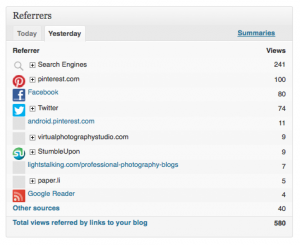There are really two parts to coming up with your blog content. First you have to come up with a blog topic that ultimately leads to your title. Second, you have to be able to write a complete article – shoot for 400 to 800 words – in a reasonable amount of time.
While the writing concept may put fear into your heart – I know it does for many small business owners – in many cases the fear starts long before the writing begins. If you can’t come up with a great, motivating title, how will you ever be able to follow it with great content?
When it comes to brainstorming your ideas for titles, there are many ways to go about it. Yet one place is easy to overlook and yet can provide you with a wealth of information for what your readers are truly looking for … your analytics.
By following what people do on your site, you’ll quickly find inspiration in what to create more content around. Here’s how.
Start with your categories.
When you originally set up your blog, you choose a few categories that resonated with what you wanted to write on. For instance, on this blog, I chose main categories of blogging tips, Facebook tips, small biz marketing, social marketing and Twitter tips. Then from there, as I continued to write, I subdivided those categories down even further.
As people visit my site, some categories received more traction than others. By following what categories people click on and search through on a regular basis, I can tell where more information is needed. It can also help me decide when to create new subcategories to further add value to my site.
Look to your top performing blog posts.
When people like an article, they click and share. The more they share, the more page views that particular post will receive. By watching these statistics, you can tell “hot button” topics that are near and dear to your visitors’ hearts. This can help you not only come up with new and more detailed posts on the same subject matter, but it can also help you create future products and services as well.
Use your search box.
When visitors use the search box feature on your site, they are telling you what topics interest them right now. This is a way of cutting through the “clutter” of your site and getting right to the heart of what they need to know now.
However, as you are evaluating this, make sure you follow the trail from beginning to end. If someone performs a search, do they click on the search results presented to dig deeper into your site? Or do they leave it after the search query is performed?
In some cases it may be telling you your visitor was in the wrong place – they don’t mesh with your overall business mission. In other cases, it can give you clues about how your visitors vocabulary may be different than yours – giving you another opportunity to create a blog post.
Evaluate your referral traffic.
What sites are referring you? Are you well connected with these sites?
When you see a site over and over again, its time to do more than receive blind traffic. Start by developing a relationship with the other site’s owner. Guest posts, interviews, or even creating a product together may be in your future if the connection is close enough.
Read your comments.
Your comments can provide you with a wealth of information. What do your readers agree with? Disagree with? What questions do they ask after reading through your material? In many cases you can lift these comments right from the source and use it to provide a new post in a short period of time. If one person has a question, you can assume many others are asking the same question as well.
Watch what people like to share.
If you share your posts regularly on places like Facebook, Twitter or Pinterest, you know some things are big hits while others are dismal failures. Some things you write are shared a half a dozen times, while the next post reaches out to thousands. Use the “thousands” to find your inspiration.
